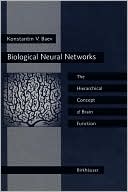Biological Neural Networks: New Concepts of Structure and Organization
Search in google:
Biological Neural Networks presents a novel conceptual framework for neurobiology achieved by the application of control theory. This new paradigm provides unifying principles for understanding the functional construction of the nervous system. Konstantin Baev argues forcefully that all hierarchical levels of the nervous system are built according to the same functional principles, which are shown to underlie the highest forms of brain function. Each network hierarchy is structurally and functionally organized in such a way that a lower control system in the nervous system becomes the controlled object for a higher one, and each level of control possesses a behavioral model of its controlled object. Baev writes with an interdisciplinary readership in mind. Neuroscientists, computer specialists and mathematicians, physicists, and clinicians devoted to deciphering the way the brain works will all find this book fascinating and stimulating reading. Thomas H. Jobe This volume is a systematic presentation of the author's theory of neurocomputation. He has developed the "functional automatism" theory of neurocomputing to a high level of conceptual clarity. He shows how Kolmogorov's theorem (1957) can be applied to the new concept of a "spiking" dendritic tree to explain learning in reflex motor activity and how hierarchies of reflexes can control manipulation of external objects by an organism. The author has successfully applied the functional automatism concept of neurocomputing to motor reflex learning and control. His purpose is also to critique competing theories of neurocomputation. This book is intended for neurobiologists, neurologists, neurosurgeons and neuropsychiatrists. It provides an ingenious model of Parkinson's Disease that explains how neurosurgical interventions that damage tissue can actually improve function. Several excellent diagrams and illustrations are included that illustrate concepts of motor control by hierarchical reflex integration. Experiments that illustrate "functional automatisms" are well illustrated. The author has achieved a lucid and well-argued presentation of his model of neurocomputation. The strength of the model rests on the fact that it originally derives from biological control systems (vonHolst) and then makes use of important analogical extensions to achieve generality and complexity not found in more "mechanical" physics based models such as those of Hopfield and Tank. The author's approach thus stands as an important biological alternative to the dominant mechanistic trend in neural network theory.
PrefaceAcknowledgmentsForewordForewordIntroduction11Limitations of Analytical Mechanistic Approaches to Biological Neural Networks72The Control Theory Approach to Biological Neural Networks483A Central Pattern Generator Includes A Model of Controlled Object: An Experimental Proof714The Spinal Motor Optimal Control System875Generalizing the Concept of a Neural Optimal Control System: A Generic Neural Optimal Control System1026Learning in Artificial and Biological Neural Networks1107The Hierarchy of Neural Control Systems1268Application of the Concept of Optimal Control Systems to Inborn Motor Automatisms in Various Animal Species1329The Stretch-Reflex System14310The Cerebellum14811The Skeletomotor Cortico-Basal Ganglia-Thalamocortical Circuit15612The Limbic System17513The Prefrontal Cortex19514Conclusion201References226App. 1The Main Properties of Sensory Information Sources and Channels243App. 2Functioning of the Internal Model of the Controlled Object246App. 3The Spinal Optimal Motor Control System as a Neural Network249Abbreviations254Index257








